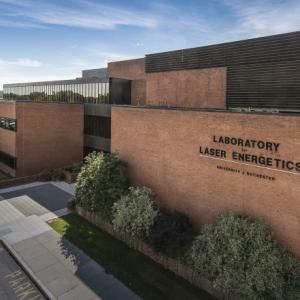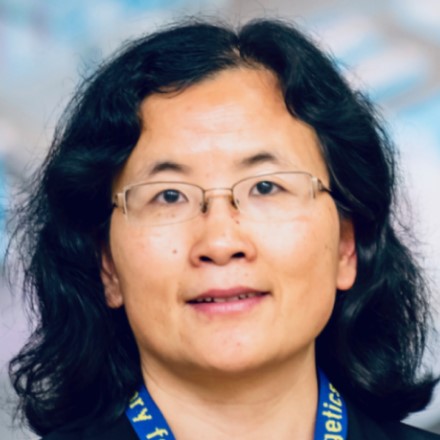Please address
inquiries to:
Email: mingsheng@lle.rochester.edu
Capabilities
OMEGA EP has four, frequency-tripled, kJ‑class, independently-configurable NIF-scale beamlines, two of which can be compressed for short pulse, petawatt-class operation. The combination of high intensity and high energy in short- and long-pulse operation combined with flexible diagnostic systems enables a wide range of experimental configurations for cutting-edge plasma, high field, high pressure materials and HED research as well as the development of advanced radiation sources for applications. A full-system shot cycle of approximately 1.5 hours is typical with 7 to 8 shots per day, however interleaved beam operation on a 45-minute shot cycle is possible for compatible experiments with 2x more shots per day. Contact the facility for current energy performance limits. The OMEGA Laser Facility at the University of Rochester (UR) Laboratory For Laser Energetics (LLE) is mainly funded by the National Nuclear Security Administration (NNSA). It provides 3-4 shot days as a member of LaserNetUS funded by the U.S. Department of Energy, Office of Fusion Energy Sciences. LaserNetUS beamtime is separate from the National Laser Users' Facility (NLUF) program funded by the NNSA. Researchers interested in the NLUF program are advised to contact LLE directly.
OMEGA EP beams 1 and 2 can be compressed for short pulse operation. Currently these beams can provide 1053 nm light with up to 0.5 kJ in 0.7 ps, 1.25 kJ in 10 ps and 2 kJ in 100 ps, with a best focus of ~30 µm diameter containing 80% of laser energy. The peak laser intensity is above 6x1019 W/cm2, with an intensity contrast of approximately 1010. Other pulse durations between 0.7 ps to 100 ps can also be supported. When operated together, the two short pulse beams propagate to two perpendicular off-axis parabolas (OAPs) in the OMEGA EP target chamber, or alternatively are combined to co-propagate along a single ‘backlighter’ (beam 2) axis. In any short-pulse configuration, remaining OMEGA EP beams can provide simultaneous long-pulse operation. It is also possible to transport the short pulse beam 2 (and beam 1 in co-propagation mode) to the OMEGA chamber for joint operation with the OMEGA 60 laser (Note: the joint operation is not included for LaserNetUS).
All four OMEGA EP beams can provide long-pulse (0.1 to 10 ns for each individual beam) operation to the OMEGA EP target chamber. In this mode, the beams provide frequency-tripled light (351 nm) in individually-configured pulse shapes, each containing up to 5 kJ. Contact the facility for all previously-used pulse shapes; custom pulse shapes can be produced upon request. Distributed Phase Plates (DPPs) are used to produce smooth supergaussian focal spots (exponent = 8) with diameters of 400 to 2000 microns; equivalent target plane images are available upon request. Best focus without DPPs produce a spot size of ~100 μm.
OMEGA EP additionally provides users a wide range of flexible diagnostic systems. Three dedicated Target Positioning Systems (TPS) enable control for multi-target geometries. Five Ten-Inch Manipulators (TIMs) provide a standardized fielding platform compatible with over 60 instruments, in addition to about 20 fixed-port diagnostics. Commonly used techniques include gas-jet plasma generation, externally generated magnetic fields up to 50 Tesla, x-ray imaging, spectroscopy and radiography, proton radiography, electron/positron and ion spectroscopy, powder x-ray diffraction, velocimetry (VISAR) and streaked optical pyrometry (SOP), and 4ω optical probing. LLE is committed to working with outside users to develop and introduce new diagnostic systems based on the users’ needs. A full list of current diagnostics is available upon request.
The Omega Laser Facility at UR/LLE is the largest university-based national laser user’s facility in the world. UR/LLE has over 40 years of experience supporting experiments of outside users including external academic users at its world-class laser facilities. OMEGA EP offers LaserNetUS users high availability and experimental effectiveness (> 95%, according to post-shot user surveys) as well as a user-friendly culture: outside users conduct 60% of experiments performed on the Omega Laser Facility, supporting the National Nuclear Security Administration’s science-based Stockpile Stewardship including academic research and training of students through the National Laser Users’ Facility Program. The researchers at UR/LLE and members of the Omega Laser Users Group (OLUG) community will provide LaserNetUS researchers access to a broad range of expertise in laser-driven experiments and modeling.
Requests for all visits by users of the Omega Laser Facility must be submitted online by filling out the LLE Visitor Information Form available at the LLE home page (https://www.lle.rochester.edu/) on the “About” tab, “Visitor Information” section. Visitors who are not citizens of the United States must submit their request 60 days in advance of the proposed visit date to allow sufficient time for any necessary government review. All other visiting users must submit their requests at least two weeks in advance of the proposed visit date to provide for the proper badging and access required.
The spokesperson for an accepted LaserNetUS proposal (e.g. they who submitted the proposal) will be asked to name a principal investigator (PI) for the experiment who will undergo a PI training at LLE at least three months in advance of shots. LLE and the facility will work with and guide the PI through the steps of preparing for their experiment following the established procedures. Prospective and successful PIs are encouraged to participate in the annual Omega Laser Facility Users Group (OLUG) Workshop scheduled in April at LLE.
https://www.lle.rochester.edu/
Mingsheng Wei, mingsheng@lle.rochester.edu
| Parameter | Value | Unit | Additional Information | |||
|---|---|---|---|---|---|---|
| Center Wavelength | 351 | nm | ||||
| Pulse duration (I FWHM) | 0.1 | ns | 0.5 | 1 | 3 | 10 |
| Max energy on target per beam | 100 | J | 500 | 1250 | 3000 | 5000 |
| Shot energy stability | ±10 | % | r.m.s. | |||
| Focal spot at target | ||||||
| F/number | f/6.5 | |||||
| intensity FWHM | 100 | μm | Various DPP sizes: 400 um, 750 um, 800 um, 1100 um and 1800 um | |||
| Strehl ratio | (unknown) | |||||
| Energy containment | ||||||
| Pointing Stability | 25 | μrad | ||||
| Repetition Rate | 1/90 | min-1 | ||||
| Parameter | Value | Unit | Additional Information | |||
|---|---|---|---|---|---|---|
| Center Wavelength | 1054 | nm | ||||
| Pulse duration (I FWHM) | 0.7 | ps | 2 | 5 | 10 | 15-100 |
| Max energy on target | 300 | J | 450 | 700 | 900 | 1000 |
| Shot energy stability | ±10 | % | ||||
| Focal spot at target | ||||||
| F/number | f/2 | Calculated using the beam diagonal; f/3 to f/50 with sub-aperture apodizers (reduced energy) | ||||
| intensity FWHM | 15-20 | μm | R80 | |||
| Strehl ratio | 0.1 | |||||
| Energy containment | 80 | % | within | 15-20 | µm | radius |
| Pointing Stability | 25 | μrad | ||||
| Pre-pulse contrast | ||||||
| ns scale | 10-10 | @ | 2 | ns | ||
| ps scale | 10-8 | @ | 175 | ps | ||
| Repetition Rate | 1/90 | min-1 | ||||
| Parameter | Value | Unit | Additional Information | |||
|---|---|---|---|---|---|---|
| Center Wavelength | 1054 | nm | ||||
| Pulse duration (I FWHM) | 0.7 | ps | 2 | 5 | 10 | 15 - 100 |
| Max energy on target | 500 | J | 600 | 950 | 1250 | 1400 – 2000 |
| Shot energy stability | 10 | % | rms | |||
| Focal spot at target | ||||||
| F/number | f/2 | Calculated using the beam diagonal; f/3 to f/50 with sub-aperture apodizers (reduced energy) | ||||
| intensity FWHM | 15-20 | μm | ||||
| Strehl ratio | 0.1 | |||||
| Energy containment | 80 | % | within | 15-20 | µm | radius |
| Pointing Stability | 25 | μrad | ||||
| Pre-pulse contrast | ||||||
| ns scale | 10-10 | @ | 2 | ns | ||
| ps scale | 10-8 | @ | 175 | ps | ||
| Repetition Rate | 1/90 | min-1 | ||||
| Parameter | Value | Unit | Additional Information | |||
|---|---|---|---|---|---|---|
| Center Wavelength | 1054 | nm | ||||
| Pulse duration (I FWHM) | 0.7 | ps | 10 | 100 | ||
| Max energy on target | 5 | J | 90 | 1000 | ||
| Shot energy stability | 10 | % | rms | |||
| Focal spot at target | ||||||
| F/number | f/2 | Calculated using the beam diagonal; f/3 to f/50 with sub-aperture apodizers (reduced energy) | ||||
| intensity FWHM | 15-20 | μm | ||||
| Strehl ratio | 0.1 | |||||
| Energy containment | 80 | % | within | 15-20 | µm | radius |
| Pointing Stability | 25 | μrad | rms | |||
| Pre-pulse contrast | ||||||
| ns scale | 10-10 | @ | 2 | ns | ||
| ps scale | 10-8 | @ | 175 | ps | ||
| Repetition Rate | 1/90 | min-1 | ||||
Contacts
Please address
inquiries to:
Email: mingsheng@lle.rochester.edu

